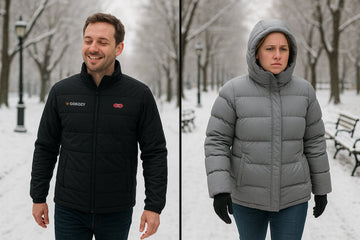Heated vests are a smart way to stay warm during outdoor activities, chilly commutes, or brisk walks. But when nighttime temperatures drop—especially while camping or sleeping in unheated rooms—some people wonder: can you safely sleep in a heated vest?
Let’s look at what experts say, the risks involved, and the best ways to stay warm overnight without compromising comfort or safety.
Why People Consider Sleeping in a Heated Vest
There are plenty of reasons why someone might want to wear a heated vest while sleeping:
- Camping in cold weather or sleeping in a car
- Living in underheated homes
- Needing targeted warmth for chronic pain or poor circulation
It’s understandable. Heated vests provide focused warmth without the bulk of electric blankets or space heaters. But does that make them safe for overnight wear?

Is It Safe to Sleep in a Heated Vest?
Most high-quality heated vests, like those from GOKOZY, use low-voltage batteries (typically 5V or 7.4V) and have safety features like temperature regulation and auto shut-off. However, experts caution against using any battery-powered device for prolonged, unattended use—especially during sleep.
Why?
- Prolonged heat can cause skin irritation or overheating
- Sleeping positions may press on wires or heating zones
- Battery packs may shift or disconnect during the night
What Manufacturers and Experts Recommend
Most heated vest brands—including GOKOZY—do not recommend wearing a heated vest to bed. These garments are intended for daytime wear while awake and moving. The safety systems are designed for short-to-medium-term use with the user present and alert.
Using a heated vest overnight, especially without supervision, increases risk—even if the vest includes auto shut-off features.
Safer Alternatives for Staying Warm at Night
If staying warm overnight is your goal, there are safer and more comfortable options than sleeping in a heated vest:
- Use a low-wattage electric blanket with automatic shut-off
- Layer thermal sleepwear and a well-insulated sleeping bag
- Use a heated vest to pre-warm your bed, then remove it before sleeping
These options reduce risk while still keeping you comfortable through the night.
If You Still Choose to Sleep in One...
We don’t recommend it—but if you do, here are safety guidelines to minimize risk:
- Use the lowest heat setting possible
- Ensure the vest is fully charged before bed—avoid using while charging
- Place the battery away from your head or neck area
- Sleep on your back to avoid compressing wires or heating panels
- Do not use if you toss and turn heavily at night
And never allow children or elderly individuals to sleep with heated garments unless supervised.

Final Thoughts
Heated vests are fantastic for on-the-go warmth—but when it comes to sleeping, safety should always come first. While the temptation to stay toasty all night is real, it’s better to choose alternatives that are designed specifically for sleep.
Stay warm—but stay smart. Use your heated vest when it’s safest and most effective: during waking hours, outdoor adventures, or cozy evenings on the couch.
Explore GOKOZY’s heated vest collection for reliable warmth built for real life.






